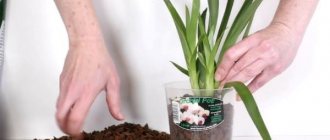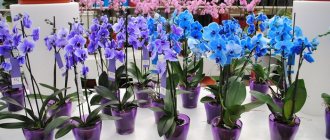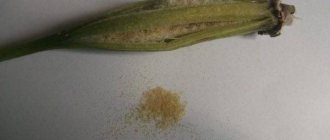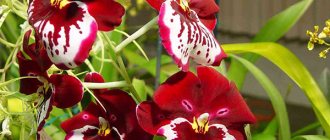Learn how to paint an orchid at home
The variety of orchid varieties never ceases to amaze. Not only are there at least 30,000 pure species, but there are also hybrids, the number of which is about 150,000. Each variety has its own characteristics in care and cultivation. An incredible palette of colors will satisfy the most sophisticated preferences, and the plant will fit into any interior.
Growing orchids has long become a kind of hobby. Fans of these exotic plants often think about what unusual specimen they can buy for their collection.
In the difficult search for original copies and unique colors, it is very easy to fall into the trap of cunning sellers. Due to ignorance of what colors orchids come in, you may accidentally purchase an artificially colored flower.
Nature itself took care of the variety of colors of orchids.
Orchid colors
Natural
Every year more and more varieties of orchids appear in nature. However, in order not to get into trouble when buying a new pet, you should know their basic natural colors
- for example, in species such as dendrobium, colors such as bright yellow, pink and snowy white ;
Some colors of dendrobiums.
Precious ludisia in nature.
Some color options for Paphiopedilum.
Grammatophyllum speciosum, also called Tiger Orchid or Tiger Orchid.
Variety of colors of phalaenopsis.
In fact, in the modern world, even in nature, you can find orchids of the most unusual colors. that black orchids, as well as deep blue, bright green and bright orange, do not exist in their natural habitat
Artificial
New colors of orchid flowers are produced in the following ways:
- injection using ink;
- watering using colored water.
Experts say that both methods have a negative effect on the plant . This is especially true for the second option, since when watering with colored concentrated water, the plant is very likely to simply die due to poisoning by chemical elements.
When you enter a flower shop, your eyes widen at the variety of varieties presented. Whatever colors you find, often such flowers do not even exist in nature, but only experienced flower growers know this.
Bright blue phalaenopsis, for example, does not exist in nature. And if such a specimen flaunts on the store counter, then, most likely, this is a clear result of coloring, and not a selectively bred variety.
Useful tips
- It is best to purchase a blue orchid at specialized flower exhibitions : even if it is painted, it was done by specialists, carefully and in compliance with all precautions;
- Caring for a blue orchid is generally no different from standard care , but you should be more attentive to any changes in its condition;
The blue orchid lives shorter than all the others.
How to paint an orchid at home?
Choosing a coloring agent
If the decision to become the owner of a blue orchid is unshakable, experts recommend painting the plant yourself. Unscrupulous sellers often use ordinary ink, after which the plant simply will not survive.
to color flowers . Another more or less safe way is to use food coloring.
Execution technique
You should start the coloring procedure by choosing an orchid. In order for the color to live up to expectations, it is recommended to take a plant with white inflorescences.
It is better to choose white orchids for coloring.
There are two methods for painting orchids:
- through watering;
- using injections.
Gardeners prefer the watering method because it is considered more gentle. However, the effect of such coloring is of poor quality. Along with the flowers, the petals are also colored, which makes the plant seem artificial, and the color does not last long . Once watering with the blue solution is completed, the plant will quickly return to its previous color.
How the watering method works:
- you should mix the purchased paint with water;
- Water the flower with the resulting solution in the standard watering mode.
Voila - a unique blue flower will flaunt on the windowsill.
The second method of staining,
injection, is not recommended by gardeners , since it has a detrimental effect on the condition of the plant, but is more effective.
If, nevertheless, the choice fell on this method, then preference should be given to gentle methods of introducing the dye in order to cause the least harm to the plant. Typically, the dye is injected into the peduncle, stem or root.
The most dangerous method , which both weakens the plant and leaves external defects, is introducing dye into the roots or stems . It is virtually impossible to save such a plant after flowering.
Things are different if the dye was introduced into the peduncle. You can save the flower by simply cutting off the damaged area and replanting it.
The painting procedure is simple:
- dissolve the dye in water;
- fill the syringe with the resulting solution;
- carefully inject into the selected area.
Consequences
Not every plant can safely withstand such aggressive external intervention as coloring. An orchid is a capricious and whimsical plant, and even the slightest changes in care often lead to serious consequences. A painted orchid requires even more attention and care.
When stained, both the leaves and roots of the plant are affected.
Often, after the procedure, the orchid begins to hurt. Do not forget that coloring does not change the genetic code, it is only a temporary measure. It is better to try to find types of orchids whose natural color will be as close as possible to the desired one.
For example, if your soul asks for a blue orchid, you should pay attention to some varieties of phalaenopsis, the natural color of which has a blue tint. Finding such plants is difficult, but possible. After all, it’s more pleasant when the natural “outfit” of flowers pleases the eye.
Why does an orchid change color?
Nowadays you can find the Phalaenopsis orchid in almost every home. This plant has gained great popularity due to its magnificent flowering and unpretentious nature. I did not escape the craze and became the happy owner of this magnificent blooming miracle.
I must say that the orchid has been making me happy for about two years now: it is growing, developing and blooming. And yet, this plant has one interesting feature that is practically not mentioned anywhere - during different periods of flowering, the Phalaenopsis orchid changes the color of its flowers. Let me make a reservation right away - this does not happen with all plants and, of course, the color does not change radically - from red to white, for example, we are talking more about the nuances of color, however, this phenomenon does occur.
Look at the photo of a blooming orchid:
And here is the same orchid six months later (with more delicate flower colors):
As you can see, there is a difference and quite significant.
Having become interested in this phenomenon, I began to look for more information, and it turned out that this phenomenon occurs quite often. However, there is still no consensus on why such a change in flower color occurs. Here are just some of the likely reasons cited by orchid lovers:
- Coloring of orchids by sellers. This is unlikely to apply to my orchid, but the phenomenon is unfortunately common. Most often, white orchids are painted in some bright color, for example, blue or blue.
[!] Remember, the blue phalaenopsis orchid is a very rare and expensive variety; it cannot be purchased in ordinary flower shops at a low price.
Flower buyers are seduced by the unusual shade and willingly purchase an orchid. But, over time, the effect of the chemicals that affect the color weakens, and the orchid turns into an ordinary white phalaenopsis.
- Aging orchid. There is an opinion that as orchid flowers age, they become paler. Just as the aging of people is accompanied by a loss of hair pigmentation (gray hair), so the aging of a plant is characterized by a less bright color of leaves and flowers.
- Insufficient lighting. According to this version, orchids bloom less brightly in autumn and winter, as the number of sunny days decreases; in summer, the color appears fully. This theory is not very close to me, because for my flower everything was exactly the opposite - bright color on cloudy winter days and pale in midsummer.
- Reducing the amount of fertilizer. It is no secret that before sale, flowers receive enhanced bait from special preparations, which allows the orchid to maintain its presentation for as long as possible. At home, as a rule, we rarely feed orchids with ordinary complex fertilizer. It is quite possible that thanks to such tricks from sellers, orchids in stores bloom brighter and richer than under normal conditions.
- General change in the conditions of keeping orchids. Temperature, humidity, lighting - all this, of course, changes when an orchid moves to a new place of residence from greenhouses and conservatories. These factors together can cause an orchid mutation.
In addition to changes in flower color during different flowering periods, there may be the following plant metamorphoses:
- Different colors of flowers on different peduncles of the same plant . Surprisingly, some orchids, producing several flower stalks, are able to change the color of the flowers on each of them. Of course, this is not a radical change of color; rather, the hue and brightness change, but in any case, such an orchid looks very impressive and amazing
- Different colors of flowers on one peduncle during one flowering period. Simply put, when an orchid opens its buds one by one during flowering, some of the flowers may be one shade, and some another. Again, we are talking more about the nuances of color and brightness, however, such a phenomenon does occur.
Summarizing all of the above, we can say that the flowering of the phalaenopsis orchid is a kind of lottery - what flowers will be this time: bright or pale, large or smaller, how many flower stalks the plant will produce. Well, I, in turn, will look forward to the next flowering of my orchid, so that I can admire the beauty of this plant again and again.
why does an orchid change color
- Olga also drew attention to this fact. This year I installed a phytolamp on one of the windows (eastern). It was on this window that the flowers became paler! Almost all of them. In the north, they are bright without lighting, although there are few of them. They always bloom only in the fall, so I don’t know what would happen in the summer.
Answer- Inga
they just fade in bright lightAnswer
- Masha
By the way, in continuation of the story - all subsequent times the orchid bloomed as brightly as the first time (with thick, rich purple spots). There were no more pale flowers like in the second photo. It’s a pity, in my opinion, pale pink has its own charm.Answer
- Galina
Exactly the same story with the same phalaenopsis. I like it even better this way. Blooms 3 times. Each time a different color. And the peduncle is the same.Answer
- Inga
It’s just that in the second photo there is a completely different variety of orchid, during the flowering process the color becomes paler, but it is precisely over time that the same flower becomes lighter (burns out)Answer
- Svetllana
I have 11 phalaenopsis. And now one has radically changed color: from bright pink to dark, almost black, and the flowers are small. What to do?Answer
- Lena
It's okay - wait for the next flowering. My phalaenopsis also changed color, but then everything returned to its original state. Maybe the flower reacts this way to changes in some conditions.Answer
Masha
What other variety? This is the same orchid!
Answer
- Tatiana
And my orchid bloomed creamy for three years. And now for some reason it is blooming bright crimson. How can this be?Answer
- Lena
Perhaps the conditions of detention have changed - a new place with different lighting, some fertilizer? In general, an orchid is an amazing flower that often brings surprises.Answer
- Galina
Maybe it's a reaction to the heat. Here in Saratov it is now 30-37 degrees.Answer
- Irina
Girls, who heard? What if you water a white orchid with food coloring, then the flowers will be the color they were watered with!?Answer
- Masha
I haven't heard of it, but I think I can try. You just need to use food colorings, as they are harmless and less likely to harm the flower. It will be an interesting experiment.Answer
- Valentina
Surprisingly, last year I was given an orchid with white flowers, this year it bloomed as shown in the photo, speckled, white and pink. I think maybe because I stimulated it, and having cut it, after such a pockmarked white one, I brought in some cells.Answer
- Inna
I bought a burgundy orchid with white specks, when it bloomed again, it was just white. It’s a shame.Answer
- Svetlana
In February, my son gave me an orchid with large white flowers, it bloomed quickly, about a month. A year later, also in February, they gave me an orchid with medium-sized flowers, all with dark purple veins. It bloomed for a long time, 4.5 months. Here is my white one, finally Well, after almost a year and a half I decided to bloom! And what flowers? I wrote off the color and size of the blooming violet as a chameleon! All of the reasons listed above do not fit its changes. I am not a botanist, but if they gave me a blue one, even if it was painted, would it bloom like a chameleon with blue flowers? Or is there still some kind of pollination taking place?Answer
- Pauline
Most likely, the flowers have been pollinated. This happens sometimes. It is unlikely that another orchid would bloom with blue flowers, because this is not a natural genetically endowed color, but a simple dye.Answer
- Dana
They gave me a blue orchid; it didn’t bloom for a long time, 3 years, then it bloomed with white flowers, and the purple orchid bloomed white with purple speckles.Answer
- Svetlana
My eldest orchid is almost 8 years old, the flowers have always been medium-sized pink, but this time the flowers are pure white and larger in sizeAnswer
- Anastasia
I have the oldest orchid, it is two years old (I haven’t been growing orchids for that long). And this orchid blooms on the third circle (at home only on the second) and it was bright, spotted, pink. And now it has bloomed yellow and a little pink speckled??Answer
- Lyudmila
And my yellow one with a purple tint of petals lives for 3 years in the same conditions, and bloomed 5 times with a beautiful reddish border along the edge. I love it, but I really don't want my 30+ orchids to change color.Answer
- Taya
I have two orchids, pink and white. So this year the pink one bloomed first, and then the white one bloomed, but not with pure white flowers, but with light pink ones. Looks like it's been over-pollinated...Answer
- Anonymous
On March 8th they gave me a blue orchid. At home I discovered that the peduncle was torn off at the bottom, then I waited a long time for it to bloom again. In winter it bloomed and disappointed with its white color with a slight light lilac color, and recently it bloomed again and surprised with a brightly saturated lilac color. Just a surprise flowerAnswer
- Victoria
What if the orchid changed its flower shape? What does this mean? Usually an orchid blooms with a standard flower of 5-6 petals, but this time one flower bloomed more like a peony...Answer
- Victoria
A mutation based on the principle of Siamese twins (during the process of laying two or more buds merged into one), and the result was a fluffy flower similar to a peony. This may be caused by excessive and/or improper feeding.Answer
- Natalia
In my orchids, I noticed a change in color (not as significant as that of the author of the article) and the size of the flowers of the orchid after resuscitation: removing leaves or growing roots. By the way, such spotted orchids, hybrids, and “harlequins” are prone to such tricks with color changes. And blue (or bright pink, dark purple and other unnatural tones) can color an orchid and lilac (pink), any common color, the “cheapest” orchid.Answer
- TATIANA
I have 16 orchids, all of different colors. One bright yellow one with a red center, it surprised me with a large number of peduncles (now there are 3 flowering ones). When they bloomed, they always threw out a new peduncle in addition to the old ones. And besides, they all had flowers, both old and new. Now one of the five is blooming and not yellow at all. and dark burgundy I couldn’t confuse it Because it’s the only one that blooms like a tree.Answer
- Kate
The change in color of orchid flowers occurs due to a change in maintenance conditions. Orchids that bloom in autumn or winter are always different from those that bloom in spring and summer. Orchids cannot cross-pollinate among themselves without help.Answer
- Sergey
Almost two years ago, on March 8, I bought a blooming orchid in Pyaterochka. I don’t know what the species is called. The flowers were white with blue veins. That same year it bloomed again, around September, but with blue flowers with white veins. Now, at the end of June, it has bloomed for the third time with pink flowers... just a plant chameleon...Answer
- Svetlana
girls, tell me what to do with the orchid after flowering, trim it? move to another place? water?Answer
- Ivanka
If the peduncle is alive, don’t cut it. But if it starts to dry out, then yes, cut it off.Answer
- Olga
It bloomed white with pink stripes for 3 years, and now a plain dark burgundy color has bloomed!Answer
- Natalie
And I have the same story, orchids change color. I noticed the heat has a bad effect on them. Even if I constantly open the window and spray water on the leaves, in the spring at 16-18 ° and with humidity it bloomed much brighter! I have 9 orchids and all different colors. I’m just hooked on them; if I see a beautiful orchid in a store, I just want to buy it. But they bloomed a little for me. As the heat began at the end of June, the flowers began to drop. I water correctly and feed once every 10 days in the summer.Answer
- Svelana
This year, too, my white orchid with large flowers blossomed into a burgundy speck, and last year it bloomed next to the same one as in the first photo. It seems that she was cross-pollinated with the hazel grouse. Moreover, the children of the white one also bloomed with white flowers nearby. The white one gave birth to two children. But there are already five burgundy ones, and they are all growing. The first one has already bloomed twice. Amazing flower. And what a hardworking mom.Answer
- Ivanka
And for New Year I was given a white orchid. It bloomed quite quickly. The arrow of the peduncle dried up and I cut it off. But already on MAY 9 there was a triple peduncle with 21 flowers on my window. Today is the beginning of August, my beauty is still pleasing to the eye.Answer
- Irina
And my 5 orchids turned white, only the centers are different and the size of the flower has changedAnswer
Leave a comment Cancel reply
Features of care
The condition of the plant is primarily affected by the correct relationship between watering and lighting.
For full natural light,
windows facing west are suitable. This accommodation option is perfect both in summer and winter.
The south side is also perfect for winter, but the north and east windows are a bad option . For a painted orchid, you should provide as much natural light as possible.
The frequency of watering a flower directly depends on the lighting. The brighter the light, the more water the flower needs. Experts recommend watering a colored orchid once a week with sufficient light
In sunny weather, the flower will need watering more than ever; in cloudy weather, the orchid will stop absorbing moisture. To determine the dryness of the soil, use a regular wooden stick. The water pressure should be weak and diffuse.
You cannot replant the plant after painting ; another stress for the orchid can be disastrous. Apart from replanting, there are no other restrictions; care requirements must be observed exactly the same as for a regular, healthy flower. However, you need to closely monitor the condition of your pet and quickly respond to any changes.
If the buds fall off after purchase , the plant did not survive the resulting stress. In this case, measures should be taken to quickly resuscitate the flower.
If, after painting, the orchid’s buds fall off, it must be urgently revived.
Can it be painted?
Almost all people who work in greenhouses know what shades exactly do not exist in nature. That is why they create copies that are in great demand. They do this in the following ways:
- using paints;
- by injection directly into the stem.
Important! If after purchase the flower has “transformed” and become lighter or, conversely, darker, it can be restored to its lost shade even at home. At home, indoor plants are tinted in the same way.
When using the first method, you need to add the selected pigment to the water and stir it well . However, after this, not only the flowers, but also the stem will be colored. To prevent the color from fading too quickly, it is necessary to periodically water the plant with dye.
To make an injection for coloring, you need to draw a dye solution into a syringe and then prick the peduncle. One injection will be enough. After any of these procedures, you need to carefully look after the orchid, because for some time it will be very weak.
Ways to color orchids blue
There are two main ways to make orchid flowers blue. The first gives a superficial color to the petals. For this purpose, special floral aerosols are used.
The second method delivers pigment to the flower from the inside, through the plant’s conducting system. This delivery can be accomplished in two ways:
| Flower coloring method | Methodology | Evaluating effectiveness |
| Surface | · a “collar” of paper is attached to the flower under the peduncle; · a stream of aerosol floral paint is directed onto the petals. | Advantages: · dyeing does not take much time; · dyeing occurs without mechanical damage to tissues; · the coloring is intense and long-lasting; · the dye remains on the surface of the petals and does not penetrate into the tissues of other organs. Flaws: · Care and precision are required when spraying paint; · flowers are painted evenly blue and look artificial; · the lifespan of flowers decreases; · newly blooming buds require repeating the staining procedure. |
| Delivery of pigment through irrigation | · the dye dissolves in irrigation water; The solution is poured into a deep container; · the pot with the orchid is placed in the solution for 15 minutes. | Advantages: · the dye is delivered to the flower without mechanical damage to the tissue; · not only processed flowers are painted, but also closed buds. Flaws: · orchid roots, leaves, bulbs and peduncles are painted along with the flowers; · flowering duration decreases; · when mixed with natural pigments in certain parts of the flower, the dye can produce brown spots; · uniformity, intensity and color fastness depend on the chosen dye; · the viability of the orchid decreases. |
| Pigment delivery by injection | · a special dye is drawn into the syringe; · the lower lateral bud on the peduncle is freed from the integumentary scale; · An injection of dye is made into the kidney at an oblique angle. | Advantages: · pigment is quickly delivered to the petals; · not only processed flowers are painted, but also closed buds. Flaws: · infection may occur at the injection site; · the viability of the orchid decreases sharply. |
Professional florists prefer to color orchids by injection into the peduncle. Despite the risk of infection, this staining method is considered the most effective.
Important! Under no circumstances should paint be injected into the root neck of an orchid. After this procedure, in more than 90% of cases the plant dies.
Can an orchid change the color of its flowers?
Changing the shade of an orchid is a fairly common occurrence that occurs as a result of artificial painting. To prevent this from happening, when purchasing, you need to make sure that there are no traces of paint on the flower. In addition, the shade may change as a result of improper care. For example, a flower may lack light, nutrients, or when changing location. However, as a result of this, the color may become only slightly lighter or, conversely, darker.
It is worth noting that orchids have become the favorite flowers of most women, because they attract attention not only with their beauty, but also with their variety of shades. In order for them to please their owners for a long time, it is necessary to provide them with proper care.
An orchid of any shade will become an unrivaled decoration for a room if you provide it with regular care and optimal conditions.
To learn how to care for orchids, watch the following video.
Having a beautiful orchid with unusual blue flowers in your home is the dream of any lover of exotic plants. However, finding such a flower is a big problem, so tools and technologies have appeared that make it possible to artificially give orchid flowers a blue color.
This is a temporary change, you should clearly understand this, because coloring does not change the genetic structure .
Choosing a dye for coloring an orchid
To color orchids, flower growers try to use different chemical dyes - from stationery ink to food coloring. Practice shows that plants react differently to these substances. The quality of coloring itself also differs:
- Stationery dyes (ink, ink, gouache paints, etc.). The most problematic material from a plant safety point of view. Stationery paints contain phytotoxic components - alcohols, viscosity and wettability modifiers, acids, etc. Painting with such substances is guaranteed to lead to the death of the orchid.
- Food colorings. Most often, flower growers use paint for Easter eggs. Blue colors are produced by dyes labeled E130 to E139. Most of them are products of coal processing or oil refining, and therefore are also unsafe for plant tissue.
- Floral aerosols. They have practically no phytotoxicity, since they are applied only to the surface of the petals. To paint orchids in blue shades, you can use “Spring pro florist” paint: for light blue – “Soft blue”, for blue – “Royal blue”.
- Floral liquid paints for fresh flowers. It is this product that is used by some unscrupulous orchid manufacturers to give plants rare colors. The speed and quality of dyeing are high, due to good solubility in water and rapid distribution of pigment throughout tissues. Complete coloring of the orchid flower occurs within a few hours after the injection.
Among liquid floral paints, the following have proven themselves well:
| Name | Description | average cost |
| "Vase Color" | Dyes available in 300 ml glass bottles. They can be added to irrigation water or used in pure form for injection. For coloring in shades of blue, “Light Blue” and “Dark Blue” dyes are suitable. | 380 rubles per bottle |
| "Erelia" | Dyes available in containers of different volumes - from 250 ml to 5 liters. Can be used with irrigation water or by injection. To obtain blue shades of varying degrees of intensity, paints numbered 4, 7, 8 and 21 are suitable. | 150 rubles for 250 ml |
Tip #1. To ensure that the color of a painted orchid is as pure as possible, it is better to test dyes on white varieties.
Caring for an artificially colored orchid
An orchid that has been dyed requires ideal conditions. You need to understand that the plant is experiencing severe stress, and it needs help to survive it with minimal losses. To help the orchid, you should pay attention to the following microclimate parameters:
- Air temperature is moderate, +18-25 0 C. Drafts are completely eliminated. Ventilation - only with forced ventilation.
- Air humidity is constant, at 60-70%. Too dry air will further shorten the flowering period, and too humid air will increase the risk of infection of the injection site with fungi.
- Substrate humidity is moderate. Watering should be adjusted so that the substrate has time to dry thoroughly. Any problems with the root system will lead to the rapid death of the plant.
Spraying of colored orchids is carried out very carefully so as not to over-wet the injection site. There is no need to feed a blooming colored orchid.
Colored orchids lose color intensity during subsequent flowering periods. As the plant gets rid of pigment, the color of the petals will return to their natural color.
Reviews from flower growers about plant paints
Flower growers who have experimented with coloring their orchids prefer professional floral pigments:
“I really wanted to surprise everyone with a blue orchid. Even after destroying one of her phalaenopsis with an injection of stamp ink, she did not calm down. I had another one - with an ugly, indistinct yellowish color, I decided to experiment on it. I took some of the paint they used to decorate roses from my friends at the flower shop and injected it into the peduncle with a syringe. The phalaenopsis was painted well, evenly, along with the buds. The paint was called “Vase Color” (Alla, Novosibirsk).
Expert opinion on artificial coloring of orchids
When designing and experimenting with plants, do not forget that orchids are living organisms.
“Personally, I consider artificial coloring of potted plants to be a gross violation of nature. They brought me a phalaenopsis for resuscitation, which, after being injected into the root collar, tried to remove the dye solution both through guttation and through the stomata during transpiration. Drops of paint stood out from everywhere. It was not possible to save the plant. Injections into the peduncle are not much better. Solutions spread through the conductive system not only from bottom to top, but also back. This is a very dangerous occupation."
A. Davydovskaya, owner of the greenhouse
External painting
A specially developed spray allows you to give flowers any color by applying aerosol paint directly to the plant. To get a flawless look, a protective screen made of paper or film is put on each flower, and paint is sprayed onto the petals. It is advisable to protect the remaining parts of the plant from paint.
As the buds bloom, the procedure is repeated. External mechanical painting is as safe as possible if high-quality preparations are used. The plant is not injured, maintaining freshness throughout its life cycle. No additional care is required; standard methods of maintaining freshness are sufficient: good lighting with diffused sunlight, watering as the substrate dries with settled water at room temperature, applying universal fertilizers 1-2 times a month.
Experts remind that any interference in the life of the plant leads to a reduction in flowering time, a weakening of the immune system and a partial loss of viability. They also claim that there is no better artist than nature. Admire flowers in their natural color, shape and state.
Found a violation? Report content











